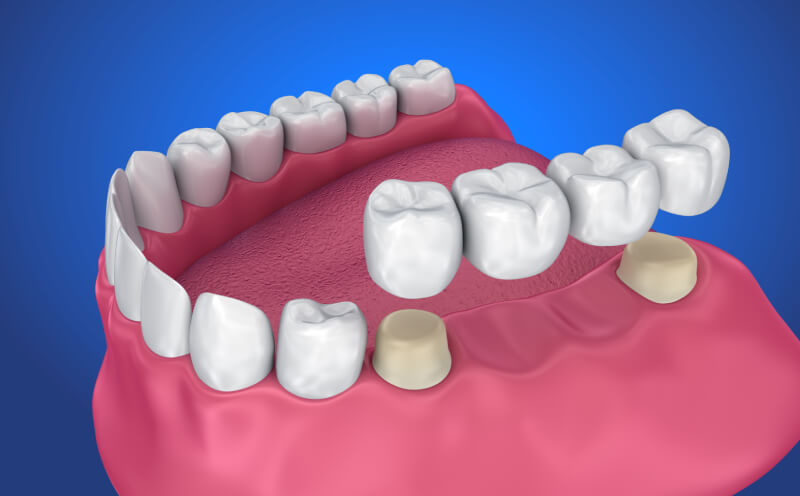A dental bridge restores the look and function of your teeth when multiple teeth are missing, including visible teeth in the front of your mouth. As the name states, it “bridges” the gap where your teeth are missing and replaces them with artificial teeth.
This treatment intends to recover biting and chewing capacities while rebuilding the patient’s smile. Dental bridges are usually made of porcelain or metal and aim to match the natural color of the teeth.
You may be a candidate for a dental bridge if you have a missing tooth or teeth and have healthy teeth on either side of the missing tooth or teeth. These teeth can be either implants or natural teeth.
Common causes of gaps in your teeth are tooth decay, gum disease, or injuries. Dental bridges fix multiple problems derived from these issues:
- Biting and chewing difficulties
- Speech impediments
- Face misshapen
- Jaw pain
- Teeth movement prevention
A dental bridge is made up of the following:
- Abutment teeth: The natural teeth on either side of the gap are covered with crowns and support the false teeth.
- Pontics: The false teeth are attached to the crowns on both sides and cover the hole.
At Pine Desert Dental, we have different types of dental bridges that adjust to every specific case.
This is the most common type of dental bridge. Dental crowns are cemented onto each of the abutment teeth to hold the false tooth or teeth in place. A traditional bridge is used when you have natural teeth on both sides of the gap created by your missing tooth or teeth.
The materials used for the crowns may vary from metal to ceramic or porcelain fused to metal.
While similar to the traditional fixed bridge, this type of bridge only needs a single abutment tooth where the attaching crown will be placed.
Like a traditional bridge, the Maryland dental bridge needs two healthy teeth on either side of the bridge. However, instead of attaching the false tooth to the natural abutment teeth with a crown, a metal wing attachment is used. The metal wings are bonded to the back of each natural abutment tooth to secure the false tooth in place.
Instead of using natural healthy teeth as the traditional bridge does, this type of bridge uses dental implants as the abutment teeth.
An implant-supported bridge requires two different surgeries. One surgery is needed to embed the implants in the jawbone. Then a second surgery is needed to place the bridge. This procedure requires a number of months to recover.
We also offer pediatric restorative dentistry services if you are seeking treatment for your kids.
Dental bridges usually need to be replaced every ten years, while implants can be a more permanent solution. The ideal option will depend on your budget, insurance coverage, and Dr. Sunitsch's recommendation for your specific case.
During your first dental bridge visit, the abutment teeth are prepared. This involves the regular crown procedure for these support teeth, which includes the reduction of the teeth in preparation for the dental cap or "crown."
X-rays and impressions of your teeth are taken, and a temporary bridge will be placed to protect your gums.
Once the first steps are done, the process for the dental bridge installation is as follows.
- The temporary bridge is removed.
- The new dental bridge is placed and fitted to your comfort.
- In certain cases, it may be necessary first to cement the bridge for a couple of weeks to ensure a proper adjustment.
After the dental bridge is placed, it may take a couple of weeks to adjust to changes in speaking and eating habits. Mild discomfort is expected. However, if swelling and bleeding around the bridge appear, we suggest contacting your dentist.
Proper dental bridge care consists of general oral hygiene, like flossing correctly and brushing your teeth multiple times a day. This will prevent gum decay that might cause the abutment or support teeth to weaken.
Regular check-ups with your dentist may extend the lifespan of your dental bridge.


